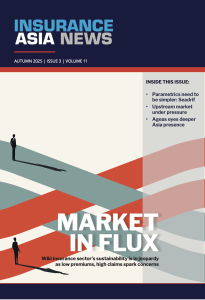Full capacity: Rising threat of political polarisation
June 28 2025 by Mithun Varkey
Welcome to Full Capacity, a weekly briefing on all the most important developments of the past week with a personal take on the news from our editor-in-chief, Mithun Varkey, delivered to your inbox every Saturday.
IAN exclusives. We reported exclusively on two notable moves in the region this week. In Hong Kong, Patrick Chan, the long-serving head of the city-based broker Nova, announced his retirement. He is being succeeded by Rebecca Au as managing director, while Joseph Lee and Conrad Wong have been given expanded roles as chief broking officers.
In Singapore, Samsung Re is continuing to build out its ambitious reinsurance expansion with the appointment of Gallagher Re’s Sie Liang Lau as head of cyber and casualty.
Going public. Hong Kong-based insurer FWD Group kicked off its twice-delayed public offering this week in a sign of recovery for the city’s struggling IPO market as well as investor appetite for insurance deals.
The billionaire Richard Li-backed insurer is looking to raise up to US$442 million with 91.3 million shares offered at HK38 (US$4.8) apiece, with a trading debut planned for July 7.
Invaluable risks. The Asian fine art market remains dynamic with economic prosperity and a surge in cultural investments driving demand for fine art and specie insurance.
However, an apparent cooling off in the global auction results points to a decline in growth from dealers and private collectors, which is reflected in the region as well.
The challenges are felt keenly in Hong Kong, where the major auction houses have had three consecutive years of declining revenues.
“We are seeing some clients reducing the values of their collections on their insurance schedules or indeed considering self-insuring completely,” said Axa XL’s Rhiannon Alban-Davies.
As China’s influence wanes, markets like Japan, South Korea, and Singapore are gaining traction, with family offices and new private museums in nearby regions driving demand for coverage and competition.
Meanwhile, fine art insurers are also grappling with a complex landscape of changing risks, largely driven by environmental, geopolitical and market dynamics.
Polarising times
This past week has been a relatively quiet one for the (re)insurance world, with no major events making the headlines after a flurry of recent turmoil.
For (re)insurers, this absence of news may seem a relief – no news is, after all, good news. However, it would be unwise to overlook the underlying simmering geopolitical tensions and its potential fallouts for the broader market.
In this context, WTW’s recently released political risk index offers compelling insights. The report examines political polarisation worldwide, highlighting three key dimensions: affective polarisation, where individuals view supporters of opposing parties as hostile; elite polarisation, which reflects how political rivals regard each other’s legitimacy; and ideological polarisation.
The findings are striking: polarisation has surged since 2000, reaching unprecedented levels.
Alarmingly, democracies – both established and emerging – seem to be bearing the brunt of this divisive fever, while interestingly, most of Africa remains largely unaffected.
Sam Wilkin, director of political risk analytics at WTW, poignantly notes, “In these polarised times, changes in government following free and fair elections can sometimes feel like regime changes. At the extreme, polarisation may be linked to political violence, leading to operational disruptions.”
This is a sobering reminder of the potential for political violence and operational disruptions that can arise from deep-seated divisions.
Political instability disrupts supply chains, jeopardises investments, and fuels underwriting uncertainty. And unlike nat cats – which, however devastating, follow predictable models – political risks are shaped by human volatility, making them far harder to quantify.
The Insurers Federation of Egypt has, this week, in fact, asserted that traditional actuarial models are no longer sufficient in light of accelerating geopolitical changes.
It has become necessary to introduce additional premiums under the “geopolitical risk” clause and reduce coverage in conflict zones, it said.
People moves
Sompo has appointed a new CEO in Hong Kong, with the insurer’s regional head of distribution Alasdair Walker, succeeding Li Sheung Kin, who will retire.
Everest Insurance has launched a South Korea desk led by Brian Jee, who has been appointed as head of Korea and senior financial lines underwriter.
Price Forbes has tapped Direct Asia underwriting manager Suvimol Sathanart as head of property for Asia.
To catch up on the most important appointments in the region, make sure to check out our weekly people move roundup.
-
Full Capacity: The year that was
- December 20
This week's newsletter discusses an IAN exclusive, Chubb's leadership switch, India's FDI increase for insurers, Vietnam's regulatory changes, Swiss Re Institute's nat cat analysis, the launch of a new APAC MGA and a 2025 round-up.
-
Full Capacity: Climate crisis strikes at Southeast Asia’s doorstep
- December 13
This week's newsletter discusses Guy Carpenter's lawsuit, this week's M&A deals, China Re's leadership change, Japan's nat-cat update, P&I renewals the South Asia floods.
-
Full Capacity: Reckoning after Tai Po tragedy
- December 6
This week's newsletter discusses broker deals in Australia, DB's Fortegra acquisition, storms in Southeast Asia and the leadership change at Allianz Re.
-
Full Capacity: Rise of the machines: AI transition and job losses
- November 29
This week's newsletter discusses the HK fire, nat cat updates, Munich Re's Australia push, Korean Re's Gift City entry, Roojai's PE funding, a P&I merger, and the AI dilemma for the insurance market.
-
QBE | Elevating customer experience, humanising claims: QBE Asia’s ‘Solutions in a Box’
Vastly improving turnaround times and personalising service delivery, QBE Asia’s award-winning, end-to-end bundled claims solutions is a game-changer for the insurance industry.
-
Beazley | What does cyber protection look like from day 1 to day 600 and beyond?
Cybersecurity is no longer just an IT concern, but a governance issue that belongs on the boardroom agenda.
-
Sedgwick | Preparing for the next storm
Insurance industry needs to recalibrate, invest in innovation and strengthen systems, talent and data practices.
-
Peak Re | From climate modelling to market opportunity: Forging a new clarity on Southeast Asia’s climate risk
Southeast Asia's protection gap: a crisis of clarity, not just capital

